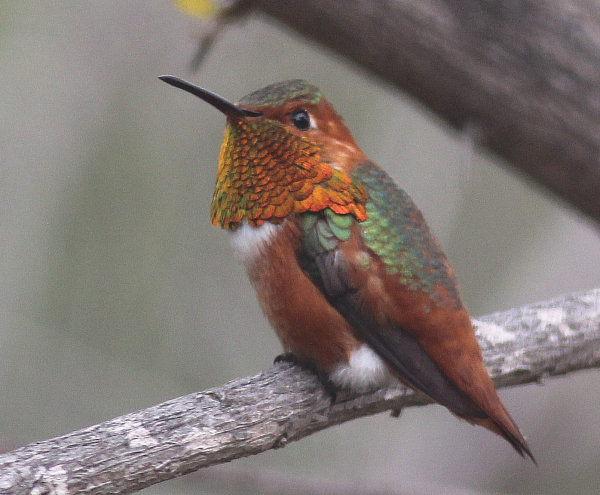
A displaying Allen’s Hummingbird is offered as an introduction to the spectacular family of hummingbirds and the photo collection at Surfbirds.com
|
If you’re a hummingbird fan you will enjoy the opportunity to study the entire family of hummingbirds, in text and photographs, in an interesting and beautifully illustrated article and photo gallery presented on the Surfbirds website. To better appreciate the hummingbirds you enjoy outside your windows, this comprehensive introduction to the Western Hemisphere’s 320 species of tiny dynamos, along with what must be an unparalleled collection of photographs provided in a species by species gallery of more than 100 hummingbird species.
The diversity of hummingbird species is greatest along the equator, and the number of species in a given location tends to decrease the farther north and south you are from the equatorial region. That means Brazil, Peru, and Ecuador host the most hummingbird species, while Canada and Chile have the least diversity. As much as we appreciate Ruby-throated Hummingbirds in our Eastern states and provinces, and the comparative wealth of hummingbirds on the West Coast, with even more in Southeast Arizona and southern Texas; if you really want to get excited about hummingbirds, check out some of the photos of hummingbirds native to Panama, Costa Rica, and Colombia.
A testament to how inspiring hummingbirds are as a family is the variety of species’ names ornithologists have affixed to them, undoubtedly the best names in the bird world; consider an abbreviated list – the Bearded Helmetcrest, Booted Rachet-tail, Brazilian Ruby, Brown Inca, Hooded Visorbearer, Jamaican Mango, Purple-backed Sunbeam, Red-tailed Comet, Royal Sunangel, Ruby Topaz, Sapphire-vented Puffleg, Saw-billed Hermit, Shining Sunbeam, Tufted Coquette – you get the idea. You can search for more exceptional hummingbird names on your own in Surfbirds’ interesting, entertaining, and informative e-article (see the link below).
Among the impressive collection of hummingbird photos, there are few female hummers represented in the collection, with the more obvious males emphasized, partly because they are often easier to photograph due to their territorial behaviors. Nonetheless, it is great fun to work your way through the photos, clicking on images that catch your attention to see an enlarged photo illustration. Also, be sure to check out the “more images” link next to many of the birds’ names.
With more than 100 species of hummingbirds represented in this Surfbirds hummingbird gallery, Surfbirds continue to look for photos of new species to add to their collection, so if you’re lucky enough to photograph a few hummingbirds in Latin America, Surfbirds may be able to use your help to fill in the blanks among their assembled species photos.
Learning more about the diverse and colorful family of hummingbirds can only enhance hummingbird experiences you witness out your window and on field trips. To review the Surfbirds article and check out the hummingbird photos, be sure to visit http://www.surfbirds.com/Features/hummingbirds.html
Share your backyard birding experiences and photos at editorstbw2@gmail.com
If you’re a hummingbird fan you will enjoy the opportunity to study the entire family of hummingbirds, in text and photographs, in an interesting and beautifully illustrated article and photo gallery presented on the Surfbirds website. To better appreciate the hummingbirds you enjoy outside your windows, this comprehensive introduction to the Western Hemisphere’s 320 species of tiny dynamos, along with what must be an unparalleled collection of photographs provided in a species by species gallery of more than 100 hummingbird species.
The diversity of hummingbird species is greatest along the equator, and the number of species in a given location tends to decrease the farther north and south you are from the equatorial region. That means Brazil, Peru, and Ecuador host the most hummingbird species, while Canada and Chile have the least diversity. As much as we appreciate Ruby-throated Hummingbirds in our Eastern states and provinces, and the comparative wealth of hummingbirds on the West Coast, with even more in Southeast Arizona and southern Texas; if you really want to get excited about hummingbirds, check out some of the photos of hummingbirds native to Panama, Costa Rica, and Colombia.
A testament to how inspiring hummingbirds are as a family is the variety of species’ names ornithologists have affixed to them, undoubtedly the best names in the bird world; consider an abbreviated list – the Bearded Helmetcrest, Booted Rachet-tail, Brazilian Ruby, Brown Inca, Hooded Visorbearer, Jamaican Mango, Purple-backed Sunbeam, Red-tailed Comet, Royal Sunangel, Ruby Topaz, Sapphire-vented Puffleg, Saw-billed Hermit, Shining Sunbeam, Tufted Coquette – you get the idea. You can search for more exceptional hummingbird names on your own in Surfbirds’ interesting, entertaining, and informative e-article (see the link below).
Among the impressive collection of hummingbird photos, there are few female hummers represented in the collection, with the more obvious males emphasized, partly because they are often easier to photograph due to their territorial behaviors. Nonetheless, it is great fun to work your way through the photos, clicking on images that catch your attention to see an enlarged photo illustration. Also, be sure to check out the “more images” link next to many of the birds’ names.
With more than 100 species of hummingbirds represented in this Surfbirds hummingbird gallery, Surfbirds continue to look for photos of new species to add to their collection, so if you’re lucky enough to photograph a few hummingbirds in Latin America, Surfbirds may be able to use your help to fill in the blanks among their assembled species photos.
Learning more about the diverse and colorful family of hummingbirds can only enhance hummingbird experiences you witness out your window and on field trips. To review the Surfbirds article and check out the hummingbird photos, be sure to visit http://www.surfbirds.com/Features/hummingbirds.html
Share your backyard birding experiences and photos at editorstbw2@gmail.com